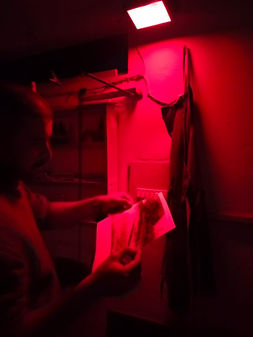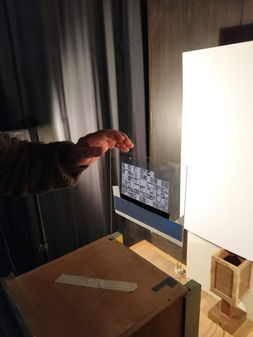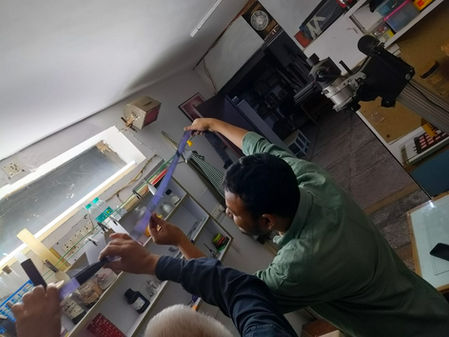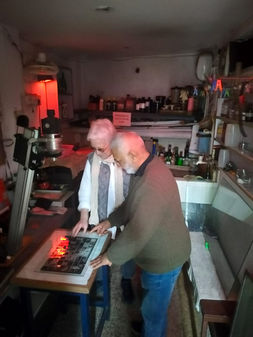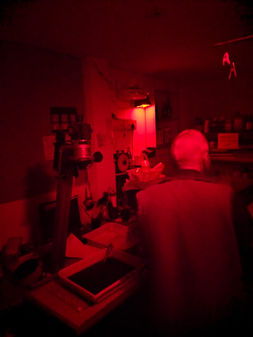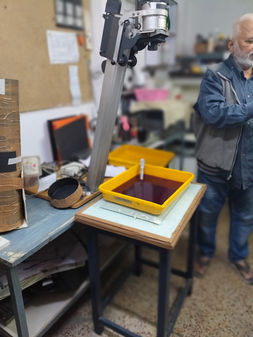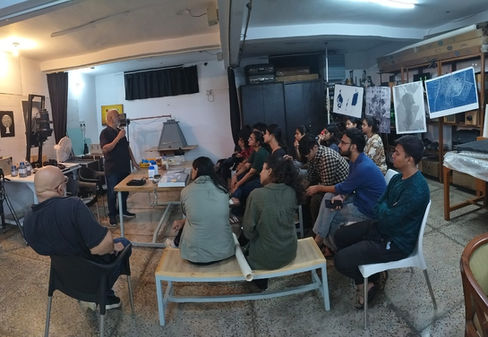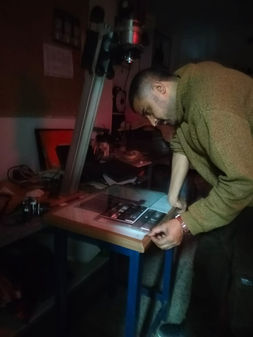The Darkroom Laboratory at Studio A89, Kaladham, is a fully equipped analogue photography facility dedicated to traditional black-and-white and alternative photographic processes. It offers a hands-on environment for photographers, students, and artists to engage with historical and experimental development techniques. The lab maintains an extensive chemical inventory, including essential and speciality compounds. This chemical archive supports diverse processes. Complemented by high-quality enlargers, film processors, and vintage photographic equipment, the darkroom promotes a holistic, tactile engagement with photography. The space is designed for both independent practice and guided workshops. The darkroom and its equipment are also available on rent, making it accessible to photography enthusiasts and professionals seeking to deepen their understanding of analogue processes.
List of ESSENTIAL
chemicals and compounds in the
DARK ROOM
LABORATORY
Currently at the Studio: Chemicals and Compounds for Alternative & Analogue Photographic Printing Processes. The list includes a few chemicals from the current inventory of chemicals and compounds available at the studio, primarily used in alternative and analogue photographic printing. These materials support processes such as cyanotype, salt printing, gum bichromate, albumen prints, and other historical or experimental methods.
The list provided below includes commonly used, lower-hazard chemicals that are suitable for educational or studio settings where minimising risk is a priority. - This is not an exhaustive list. Additional agents and modifiers may be used depending on the specific process being explored.
Acids & Acid Salts
-
Citric Acid – C₆H₈O₇
-
Boric Acid – H₃BO₃
-
Sulphamic (mild) – H₃NSO₃
-
Tartaric Acid (99.5%) – C₄H₆O₆
-
Oxalic Acid (99%) – C₂H₂O₄
Bases, Alkalis & Buffers
-
Sodium Bicarbonate (Baking Soda) – NaHCO₃
-
Sodium Carbonate (Washing Soda/Soda Ash) – Na₂CO₃
-
Sodium Acetate Anhydrous (99%) – CH₃COONa
-
Trisodium Citrate Dihydrate (98%) – Na₃C₆H₅O₇·2H₂O
-
Magnesium Carbonate (Basic Light 40%) – MgCO₃
-
Calcium Carbonate – CaCO₃
Salts & Chelating Agents
-
Borax – Na₂B₄O₇·10H₂O
-
Potassium Chloride (99%) – KCl
-
Potassium Sodium Tartrate – KNaC₄H₄O₆·4H₂O
-
EDTA Tetrasodium Salt – Na₄EDTA
-
Sodium Sulphite – Na₂SO₃
-
Sodium Thiosulphate (Hypo) – Na₂S₂O₃
Organic Compounds & Additives
-
Gelatin Powder (120 Bloom)
-
Gum Arabic
-
Vitamin C (L-Ascorbic Acid, 99.5%) – C₆H₈O₆
-
Tween (Polysorbate) (Used as a surfactant)
-
Zaboline Neutral Liquid Detergent (For cleaning equipment)
Solvents (Use with standard precautions)
-
Ethyl Alcohol (Ethanol) – C₂H₅OH
-
Isopropyl Alcohol (99%) – C₃H₈O
-
Isopropyl Rubbing Alcohol I.P. – C₃H₈O
Oxidizers & Developers (Low-risk use in controlled environments)
-
Ammonium Ferric Citrate (Green)
-
Ferric Ammonium Oxalate
-
Tannic Acid
List of Equipment presently at the studio
in alphabetical order, along with the year of purchase
(List last update MAY 2024)
Cameras & Camera Bodies
This collection spans a wide timeline of film and digital photography, featuring iconic models such as the Hasselblad 500CM, Nikon FM2, Bronica ETR, and Olympus OM-1. These cameras represent a variety of formats—from 35mm to medium format—used in both professional and experimental practices. Each camera body reflects different eras and advancements in photographic technology, allowing for versatility in lens compatibility, exposure control, and imaging style. Together, they form a robust archive for analogue photography enthusiasts, professionals, and educators alike.
-
Agfa Apotar Prontor-SVS 1:4.5/85 Camera (1980) – Compact vintage viewfinder camera with a sharp fixed lens.
-
Bronica Zenza ETR Camera with Zenzanon MC 1:4.5 f:200 mm Lens (1999) – Medium format SLR known for interchangeable lenses and accessories.
-
Bronica Zenza Camera with f:75 mm Nikkor P Lens (1999)
-
Canon EOS 30D with 24–55 mm Zoom (2007) – Mid-range DSLR with good performance for enthusiasts.
-
DSLR EOS D5 Mark III Camera Body with 24–105 mm 1:4 L IS USM Macro Lens (2013) – Full-frame professional DSLR.
-
Hasselblad 500CM Camera (Two Bodies) (1984 & 1991) – Iconic medium format modular camera system.
-
Mamiya/Sekor 1000 DTL Camera with Cosinon f/1.4 55 mm Lens (1980)
-
Minolta X-300s with Vitacon MC Zoom 1:4.0–5.6 f:28–200 mm Lens (1983)
-
Nikon FM2 with Nikkor 50 mm f/1.4 Lens (1987) – Classic manual-focus film SLR.
-
Nikon HP F3 35 mm Camera (Two Units) (1988)
-
Olympus OM-1 with G. Zuiko 1:2.8 f:35 mm Lens (1979)
-
Ricoh Singlex with Nikkor 24 mm f/2 Lens (1982)
-
Yashica FX-3 Super 2000 Camera with 50 mm Lens (1978)
Lenses
A versatile range of prime and zoom lenses compatible with different camera systems, this collection includes wide-angle, standard, macro, and telephoto optics from renowned manufacturers like Zeiss, Canon, Nikon, and Olympus. From ultra-wide to portrait-length focal lengths, these lenses are designed for precision, sharpness, and creative depth-of-field control. Whether used for landscape, studio, macro, or documentary work, each lens contributes to the overall flexibility and quality of image-making across various formats and photographic intentions.
-
120 mm CFi Macro-Planar f/4 Lens (1996) – Precision lens for close-up work on medium format.
-
150 mm Sonnar CF f/4 Lens (1997)
-
50 mm Distagon f/4 Lens (1992)
-
80 mm Planar f/2.8 Lenses (Two Units) (1984 & 1991)
-
AF Nikkor f/2.8 28 mm Lens (1987)
-
Canon Zoom Lens EF 16–35 mm f/2.8L II USM Ultrasonic (2015) – Wide-angle zoom for professional use.
-
Canon Zoom Lens EF 70–200 mm f/4L USM Ultrasonic (2007)
-
Micro-Nikkor 55 mm f/2.8 Lens (1987)
-
Olympus Zuiko 135 mm f/2.8 Lens (1979)
-
Olympus Zuiko 50 mm f/1.8 Lens (1979)
-
Zenanon MC 1:4 f:40 mm Lens (1999)
-
Zoom Nikkor 35–105 mm f/3.5–4.5 Lens (1986)
Accessories & Equipment
This section includes essential tools that support photographic practice, such as tripods, bellows, light stands, extension tubes, film processors, and more. These accessories enhance camera functionality, ensure image stability, and facilitate studio setups and on-location shoots. Also included are manual film processors and daylight tanks, reflecting hands-on engagement with film development. The presence of pinhole cameras showcases an interest in low-tech, experimental processes, adding further depth to this collection’s creative potential.
-
Accessories (Light Stand, Boom Stands, Autopoles, etc.) (1983–1990) – General studio gear for lighting and background setups.
-
Daylight Film Processing Tanks (Three Units) (1980)
-
Film Processor (Manual) (1981)
-
Flash Meter – Minolta Flash Meter IV (1988)
-
Hasselblad Accessories:
-
Extension Tube (1999)
-
Film Magazines (5 Units) (1984, 1987, 1991, 1996)
-
Flexbody (1997)
-
Polaroid Magazine (1997)
-
Proshade (1998)
-
Reflex Viewfinder RMFX (1998)
-
-
Homemade Pinhole Cameras (2000, 2010, 2017, 2022, 2023)
-
Kodak Carousel 600 Projector (1993)
-
Manfrotto Tripod (1981)
-
Nikon Bellows PB-6 (1997)
-
Tripod – Gitzo Studex (1987)
-
Tripod – Linhof Heavy-Duty (1992)
Studio Lighting
The studio lighting gear includes Elinchrom strobe units and softboxes accumulated across a decade, providing a reliable and professional lighting system. These tools are essential for controlled studio photography, enabling a range of lighting styles from high-key portraiture to dramatic still life. The collection supports both analog and digital workflows and offers consistent light output, adjustable modifiers, and robust stands, making it ideal for educational demonstrations, commercial use, or fine art projects.
-
Elinchrom Light Boxes (4 Units) (1983, 1985, 1988)
-
Elinchrom Strobe Lights (15 Units) (1983–1990)
Enlargers & Projectors
This category features well-maintained darkroom enlargers like the Beseler 23C II, Omega B22, and slide projectors such as the Kodak Carousel 600. These devices are integral to the analog printing workflow, allowing for precise enlargement of negatives onto photographic paper. Whether for educational, archival, or creative purposes, these tools offer tactile image-making experiences. With compatibility across 35mm and medium format negatives, they remain vital components of any darkroom setup.
-
Beseler 23C II Enlarger (1993) – Durable enlarger for 35 mm and medium format.
-
Dust M 605 Enlarger (1980)
-
Omega Enlarger B22 (1980)
-
Novamat Slide Projector (1992)
Meters
Including models like the Weston Master V and Sixtomat CDS, this section houses reliable handheld light meters used to measure ambient and flash lighting. These analog meters were essential before in-camera metering became widespread and remain useful for manual exposures and zone system applications. Accurate light reading tools support precise exposure control, especially in studio or low-light settings, enhancing both learning and photographic output in analog practices.
-
Sixtomat CDS Electronic Light Meter (1978)
-
Weston Master V Light Meter (1978)


